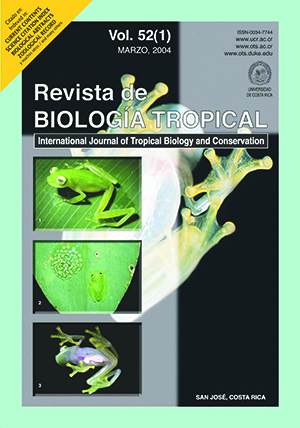Abstract
During 30 days male euglossine bees were bait-sampled at 12 sites, in the central Pacific coast of Colombia (ten days and four sites at each of three adjacent habitats: farmlands, highly disturbed forest and less disturbed forest) and 487 individuals were captured. Most captured individuals belonged to six species, five widely distributed through the American tropics and an endemic species. Two of the frequently captured species presented no different abundances between habitats, while the other four (67.97% of all the captured individuals), all of them big sized or long-tongued, were more frequently captured at the farmlands. A cluster analysis of the data matrix for the 23 captured species and the 12 sampling sites, grouped together the farmland sites, apart from the forest sites. It is proposed that male euglossine bees from generalist, long-tongued or big sized species, forage frequently at the farmlands, where fragrance or nectar resources may be clumped, less diverse, and present an access restricted by deep corollas or by microclimatic conditions of high temperature and low humidityReferences
Armbruster, W.S. 1993. Within-habitat heterogeneity in baiting samples of male euglossine bees: possible causes and implications. Biotropica 25: 122-128.
Dressler, R.L. 1982. Biology of the orchid bees (Euglossini). Ann. Rev. Ecol. Syst. 13: 373-394.
Janzen, D.H. 1971. Euglossine bees as lond-distance pollinators of tropical plants. Science 171: 203 205.
Janzen, D.H. 1974. The deflowering of Central America. Nat. Hist. 83: 48-53.
Kimsey, L.S. 1982. Systematics of the bees of the genus Eufriesea. Univ. Calif. Publ. Entomol. Vol. 95
May, M.L. & T.M. Casey. 1983. Thermorregulation and heat exchange in euglossine bees. Physiol. Zool. 56: 541-551.
Ospina, R. & J.C. Sandino. 1997. Eulaema chocoana, new euglossine bee species from the Pacific coast of Colombia. Caldasia 19: 165-174
Roubik, D.W. 1993. Tropical pollinators in the canopy and understory: field data and theory for stratum “preferences”. J. Insect Behav. 6: 659-674.
Roubik, D.W. 2001. Ups and downs in pollinator populations: When is there a decline? Conserv. Ecol. 5(1): 2. (Also available online http://www.consecol.org/vol5/iss1/art2).
Sandino, J.C. 1995. Primer inventario de abejas euglosinas en la vertiente del Pacífico del suroccidente de Colombia: diversidad, distribución altitudinal y efectos de la perturbación humana. Tesis de pregrado, Universidad del Valle, Cali, Colombia.
##plugins.facebook.comentarios##

This work is licensed under a Creative Commons Attribution 4.0 International License.
Copyright (c) 2004 Revista de Biología Tropical


